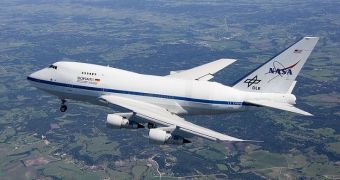The Stratospheric Observatory for Infrared Astronomy (SOFIA) telescope is the fruit of a collaboration between the American space agency, NASA, researchers at the German Aerospace Center (DLR) and the Deutsches SOFIA Institute. It is basically an infrared telescope mounted in the rear section of a modified Boeing 747, which is capable of conducting highly detailed observations of cosmic events from places that are regularly off-limits to ground-based observatories. On January 15, the airborne instrument took a six-hour flight test, during which a number of its mechanisms were activated in very much the same way they would be in case of actual scientific observations.
Some of the primary targets for the new tests included assessing the functionality of the movement and stability functions on the new telescope, which are all controlled via a centralized system. The door separating the actual telescope from the outside of the airplane was not opened during the flight test, mostly because engineers said that this was unnecessary. All the systems that passed the January 15 evaluation will be operated regardless of whether the hatch is sealed or not. The same team reveals that the observatory will be exposed during tests aimed specifically at calibrating it for space observations.
The researchers working on SOFIA also revealed that the test flight achieved its main objective, which was inertial, or gyroscopic, stabilization. This means that the telescope can stay pointed at the same object in the sky, regardless of whether the airplane shifts its course slightly, or needs to perform some other maneuvers that would otherwise modify the telescope's field of view. The system can be likened to the one on modern tanks, which are able to race over rough terrain, while at the same time keeping their gun barrel fixed on the same target.
Another important aspect of the tests was determining whether the vibration isolation system functioned within parameters or not. It is absolutely essential that the entire telescope assembly remains on its mount during the whole flight, regardless of changes on headings and altitudes. With these basic tests out of the way, Space Fellowship reports that NASA and its German partners will start focusing on conducting oped-door flights over the coming weeks. They will be aimed at analyzing how temperature variations that occur when the hatch is opened affect the stability of the mount, the telescope, and other electronic components.

 14 DAY TRIAL //
14 DAY TRIAL //